Facilitating Evidence-Based Practice: Internet Use & Blood Pressure
VerifiedAdded on 2023/03/23
|13
|1684
|99
Report
AI Summary
This report critically evaluates a research article examining the correlation between internet usage and elevated blood pressure in adolescents. The study, involving a diverse cross-sectional sample, investigates the impact of internet use on adolescent health, considering factors like race, gender, BMI, and family history. The findings suggest a significant association between heavy internet use and higher odds of elevated blood pressure, particularly diastolic blood pressure. The report discusses the study's methodology, ethical considerations, major findings, and limitations, highlighting its value to evidence-based practice and potential for dissemination. It also emphasizes the role of school nurses in promoting awareness and prevention of high blood pressure through assessment and education regarding internet use and health behaviors. Desklib provides access to this report and a wealth of other study resources.
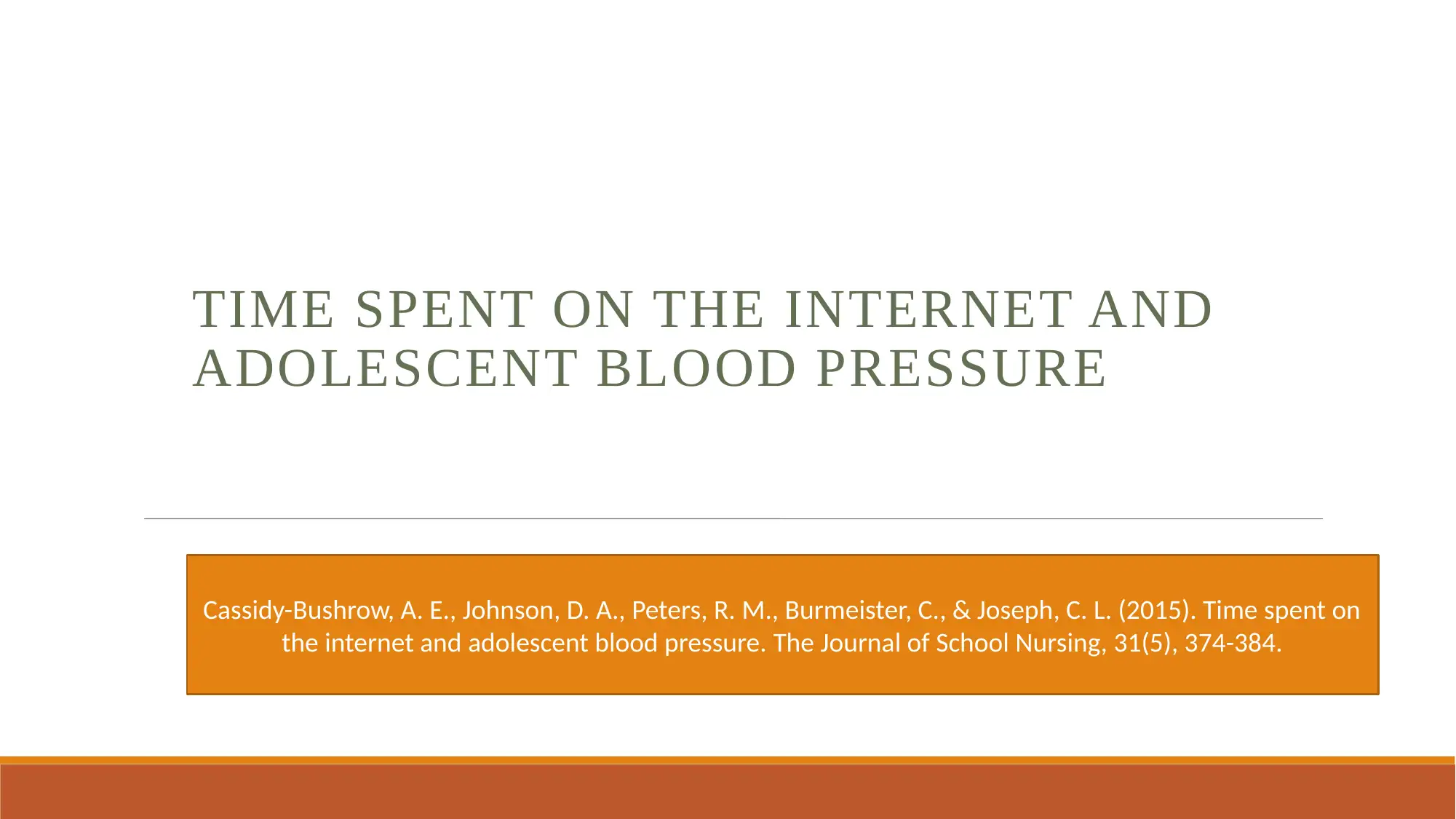
TIME SPENT ON THE INTERNET AND
ADOLESCENT BLOOD PRESSURE
Cassidy-Bushrow, A. E., Johnson, D. A., Peters, R. M., Burmeister, C., & Joseph, C. L. (2015). Time spent on
the internet and adolescent blood pressure. The Journal of School Nursing, 31(5), 374-384.
ADOLESCENT BLOOD PRESSURE
Cassidy-Bushrow, A. E., Johnson, D. A., Peters, R. M., Burmeister, C., & Joseph, C. L. (2015). Time spent on
the internet and adolescent blood pressure. The Journal of School Nursing, 31(5), 374-384.
Paraphrase This Document
Need a fresh take? Get an instant paraphrase of this document with our AI Paraphraser
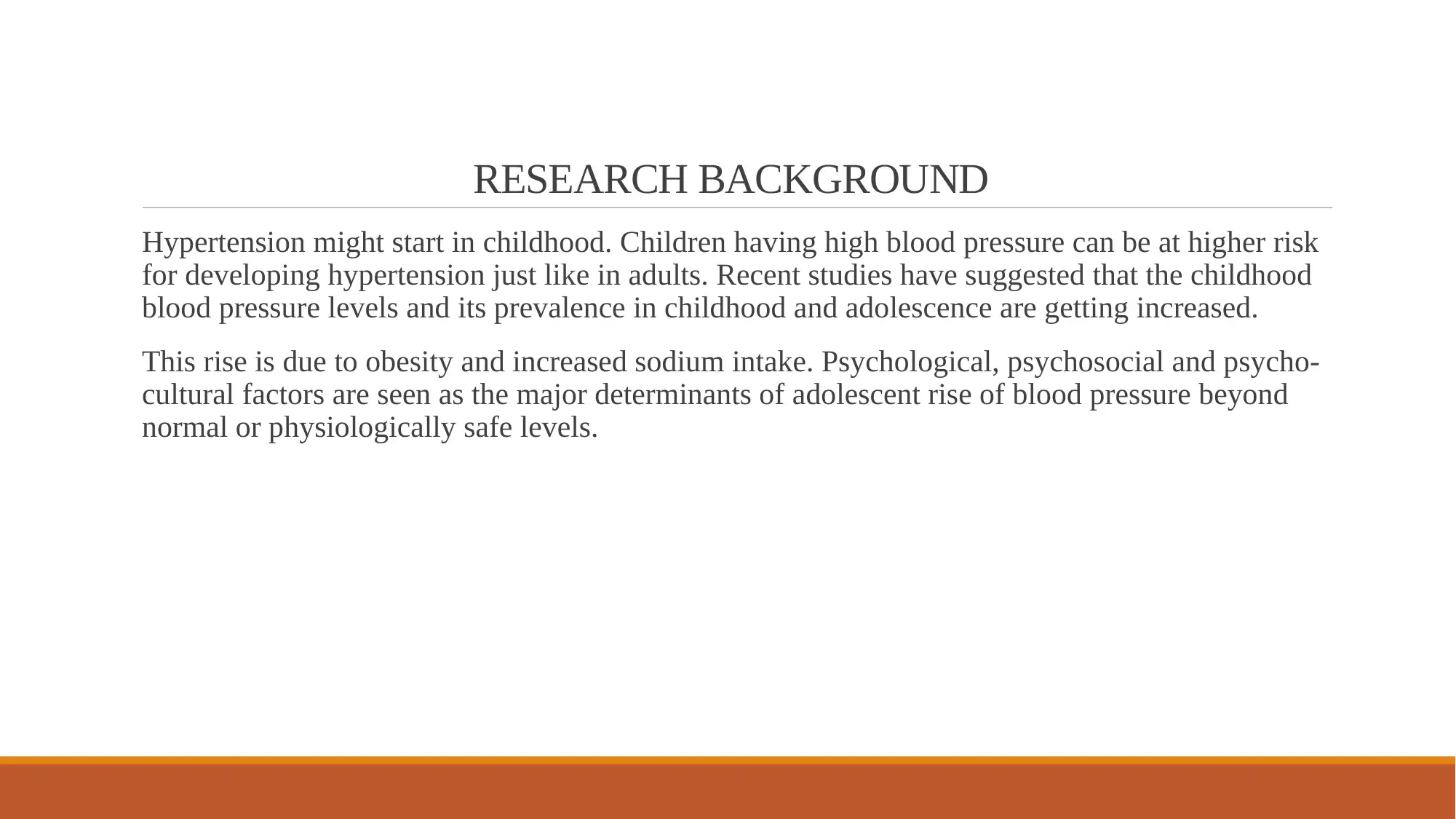
RESEARCH BACKGROUND
Hypertension might start in childhood. Children having high blood pressure can be at higher risk
for developing hypertension just like in adults. Recent studies have suggested that the childhood
blood pressure levels and its prevalence in childhood and adolescence are getting increased.
This rise is due to obesity and increased sodium intake. Psychological, psychosocial and psycho-
cultural factors are seen as the major determinants of adolescent rise of blood pressure beyond
normal or physiologically safe levels.
Hypertension might start in childhood. Children having high blood pressure can be at higher risk
for developing hypertension just like in adults. Recent studies have suggested that the childhood
blood pressure levels and its prevalence in childhood and adolescence are getting increased.
This rise is due to obesity and increased sodium intake. Psychological, psychosocial and psycho-
cultural factors are seen as the major determinants of adolescent rise of blood pressure beyond
normal or physiologically safe levels.
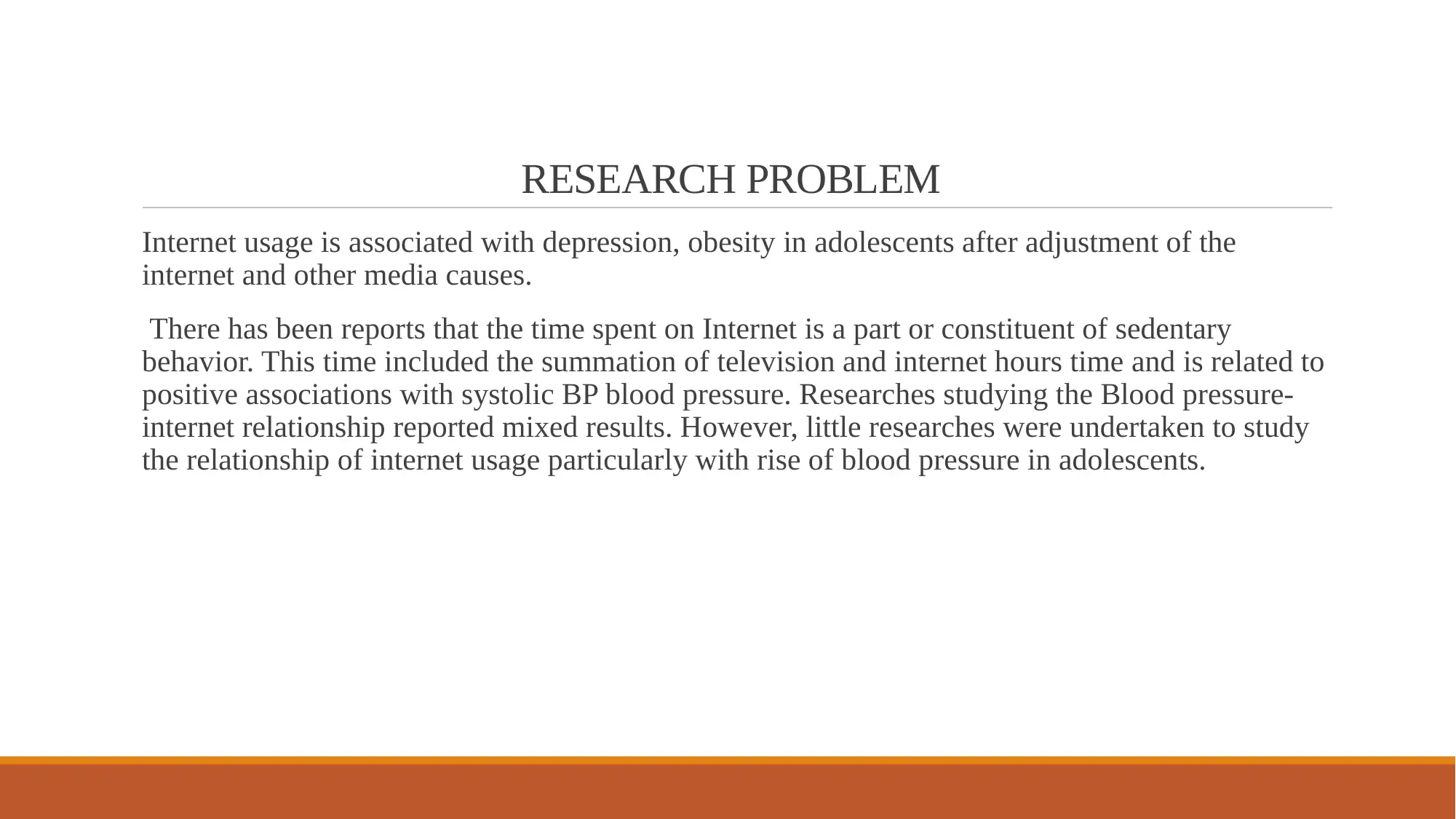
RESEARCH PROBLEM
Internet usage is associated with depression, obesity in adolescents after adjustment of the
internet and other media causes.
There has been reports that the time spent on Internet is a part or constituent of sedentary
behavior. This time included the summation of television and internet hours time and is related to
positive associations with systolic BP blood pressure. Researches studying the Blood pressure-
internet relationship reported mixed results. However, little researches were undertaken to study
the relationship of internet usage particularly with rise of blood pressure in adolescents.
Internet usage is associated with depression, obesity in adolescents after adjustment of the
internet and other media causes.
There has been reports that the time spent on Internet is a part or constituent of sedentary
behavior. This time included the summation of television and internet hours time and is related to
positive associations with systolic BP blood pressure. Researches studying the Blood pressure-
internet relationship reported mixed results. However, little researches were undertaken to study
the relationship of internet usage particularly with rise of blood pressure in adolescents.
⊘ This is a preview!⊘
Do you want full access?
Subscribe today to unlock all pages.

Trusted by 1+ million students worldwide

AIM OF THE STUDY
The study aims to examine an association between the time spent on Internet and the high Blood pressure
in diverse racial cross-sectional adolescents sample from United States.
From the study’s Abstract – “We examined the association between Internet use and elevated BP in a
racially diverse cross-sectional sample of 331 healthy adolescents (ages 14–17 years). Heavy Internet
use was defined as ≥2 hr/day, moderate use as <2 hr/day and ≥5 days/week, and light use as <2 hr/day
and ≤4 days/week. Elevated BP was defined as systolic or diastolic BP ≥90th percentile. Heavy
Internet users had statistically significantly higher odds of elevated BP compared to light Internet
users. School nurses can play an important role in preventing high BP through assessment of BP and
other health behaviors including Internet use, and health teaching to individuals, student groups,
faculty, and parents to increase awareness of the relationship between Internet use and health.”
This research is chosen because it focuses on its aim across various ethnic groups and scores high on
reliability and validity.
The study aims to examine an association between the time spent on Internet and the high Blood pressure
in diverse racial cross-sectional adolescents sample from United States.
From the study’s Abstract – “We examined the association between Internet use and elevated BP in a
racially diverse cross-sectional sample of 331 healthy adolescents (ages 14–17 years). Heavy Internet
use was defined as ≥2 hr/day, moderate use as <2 hr/day and ≥5 days/week, and light use as <2 hr/day
and ≤4 days/week. Elevated BP was defined as systolic or diastolic BP ≥90th percentile. Heavy
Internet users had statistically significantly higher odds of elevated BP compared to light Internet
users. School nurses can play an important role in preventing high BP through assessment of BP and
other health behaviors including Internet use, and health teaching to individuals, student groups,
faculty, and parents to increase awareness of the relationship between Internet use and health.”
This research is chosen because it focuses on its aim across various ethnic groups and scores high on
reliability and validity.
Paraphrase This Document
Need a fresh take? Get an instant paraphrase of this document with our AI Paraphraser
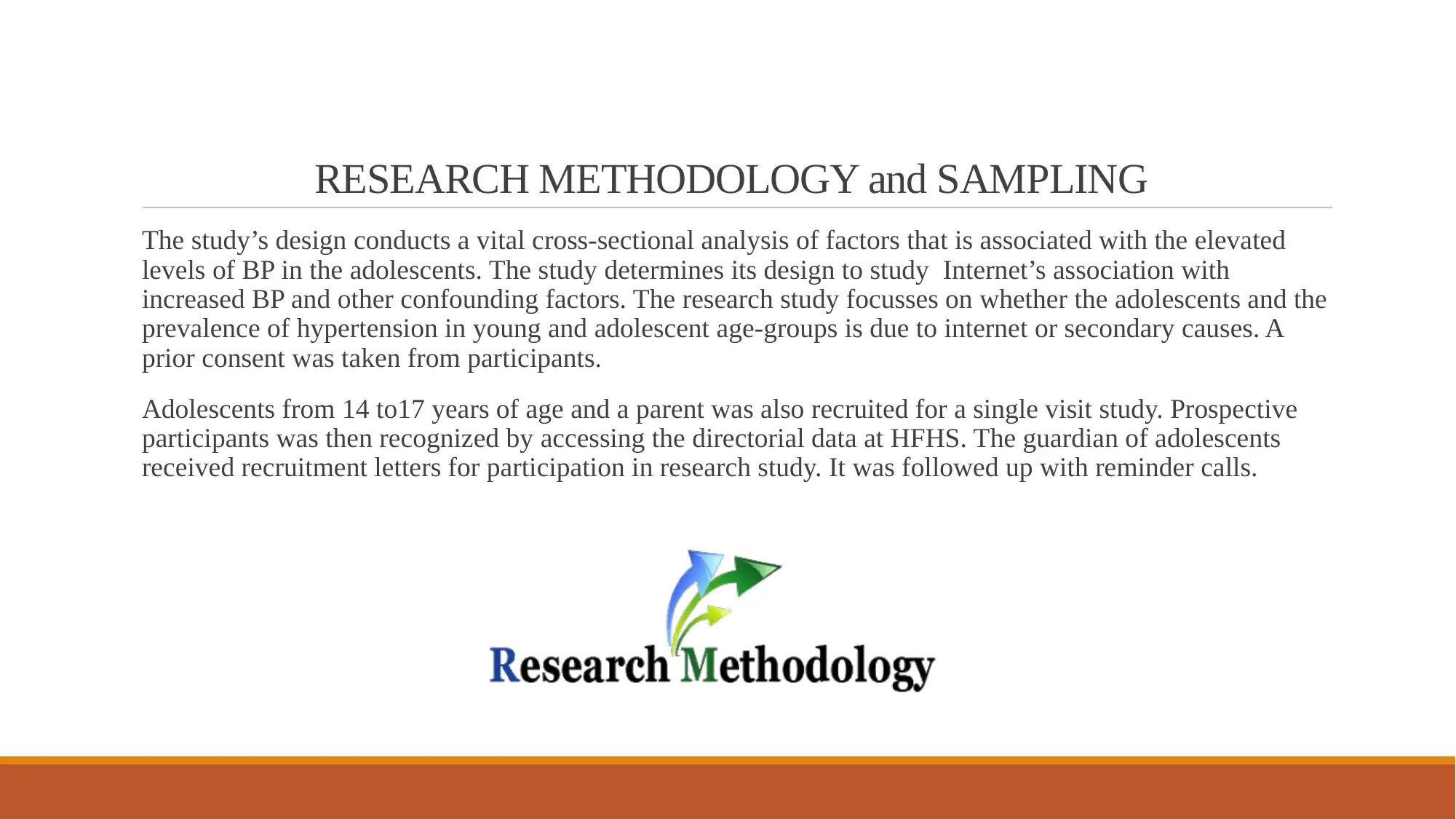
RESEARCH METHODOLOGY and SAMPLING
The study’s design conducts a vital cross-sectional analysis of factors that is associated with the elevated
levels of BP in the adolescents. The study determines its design to study Internet’s association with
increased BP and other confounding factors. The research study focusses on whether the adolescents and the
prevalence of hypertension in young and adolescent age-groups is due to internet or secondary causes. A
prior consent was taken from participants.
Adolescents from 14 to17 years of age and a parent was also recruited for a single visit study. Prospective
participants was then recognized by accessing the directorial data at HFHS. The guardian of adolescents
received recruitment letters for participation in research study. It was followed up with reminder calls.
The study’s design conducts a vital cross-sectional analysis of factors that is associated with the elevated
levels of BP in the adolescents. The study determines its design to study Internet’s association with
increased BP and other confounding factors. The research study focusses on whether the adolescents and the
prevalence of hypertension in young and adolescent age-groups is due to internet or secondary causes. A
prior consent was taken from participants.
Adolescents from 14 to17 years of age and a parent was also recruited for a single visit study. Prospective
participants was then recognized by accessing the directorial data at HFHS. The guardian of adolescents
received recruitment letters for participation in research study. It was followed up with reminder calls.
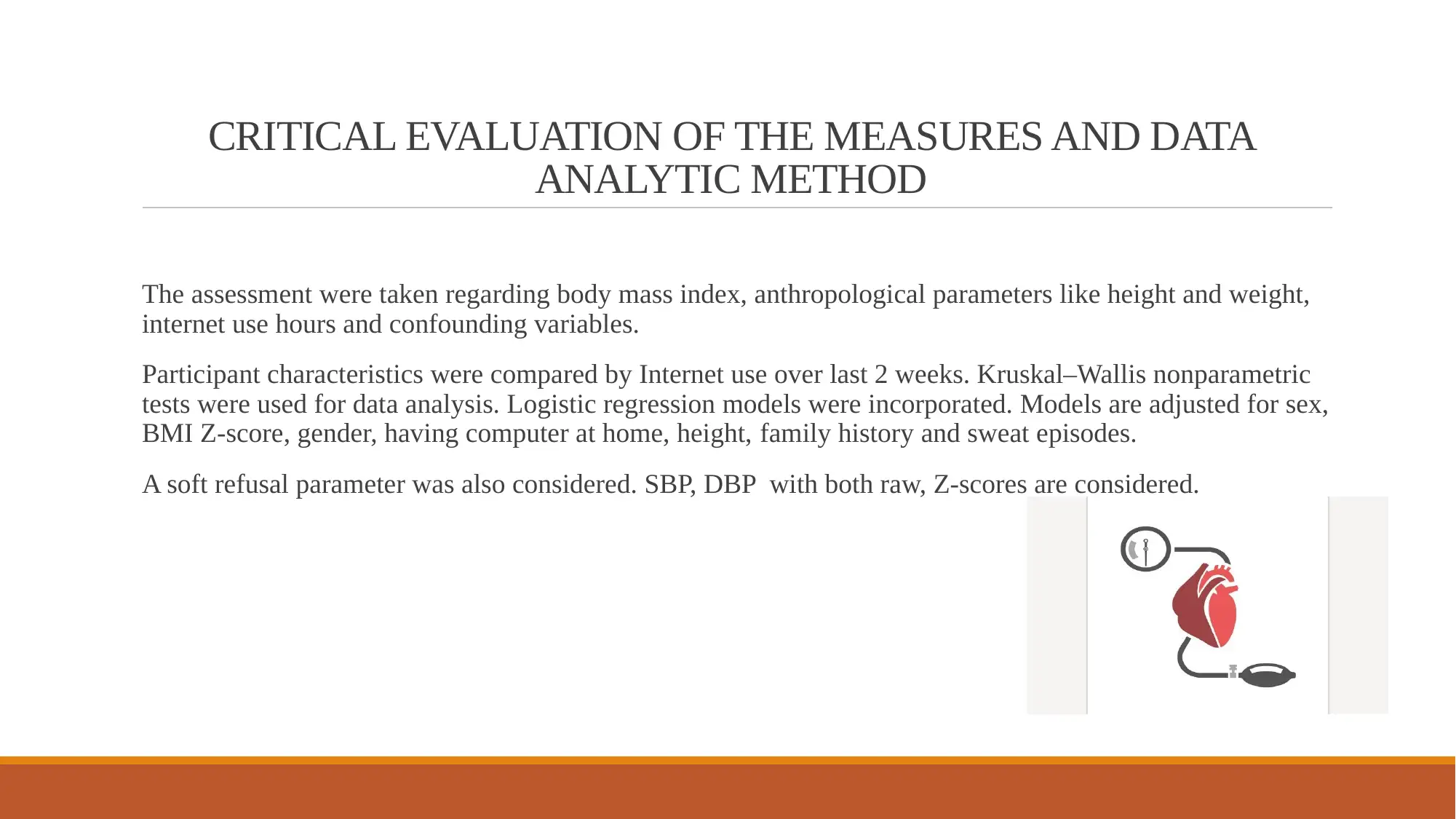
CRITICAL EVALUATION OF THE MEASURES AND DATA
ANALYTIC METHOD
The assessment were taken regarding body mass index, anthropological parameters like height and weight,
internet use hours and confounding variables.
Participant characteristics were compared by Internet use over last 2 weeks. Kruskal–Wallis nonparametric
tests were used for data analysis. Logistic regression models were incorporated. Models are adjusted for sex,
BMI Z-score, gender, having computer at home, height, family history and sweat episodes.
A soft refusal parameter was also considered. SBP, DBP with both raw, Z-scores are considered.
ANALYTIC METHOD
The assessment were taken regarding body mass index, anthropological parameters like height and weight,
internet use hours and confounding variables.
Participant characteristics were compared by Internet use over last 2 weeks. Kruskal–Wallis nonparametric
tests were used for data analysis. Logistic regression models were incorporated. Models are adjusted for sex,
BMI Z-score, gender, having computer at home, height, family history and sweat episodes.
A soft refusal parameter was also considered. SBP, DBP with both raw, Z-scores are considered.
⊘ This is a preview!⊘
Do you want full access?
Subscribe today to unlock all pages.

Trusted by 1+ million students worldwide
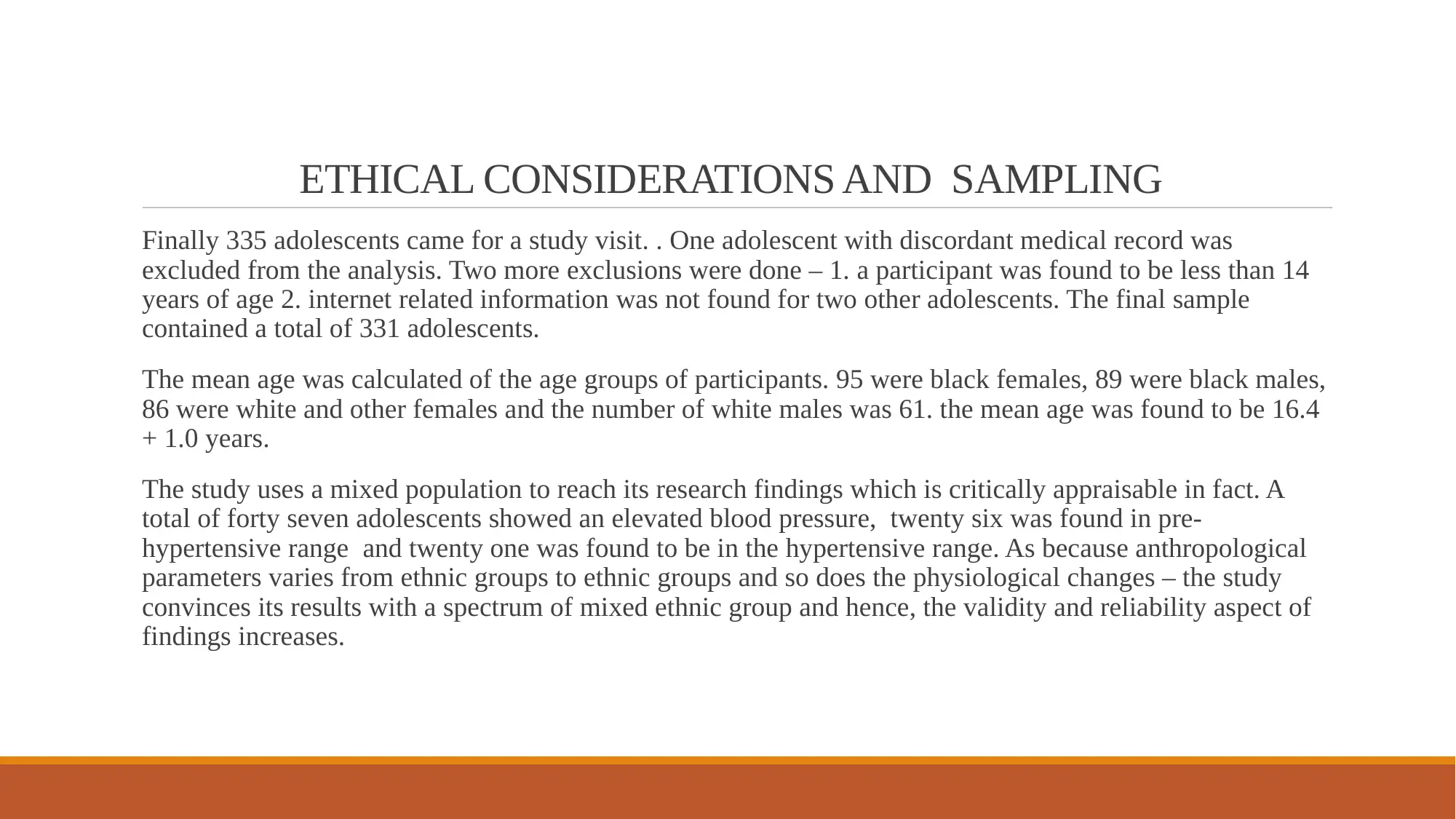
ETHICAL CONSIDERATIONS AND SAMPLING
Finally 335 adolescents came for a study visit. . One adolescent with discordant medical record was
excluded from the analysis. Two more exclusions were done – 1. a participant was found to be less than 14
years of age 2. internet related information was not found for two other adolescents. The final sample
contained a total of 331 adolescents.
The mean age was calculated of the age groups of participants. 95 were black females, 89 were black males,
86 were white and other females and the number of white males was 61. the mean age was found to be 16.4
+ 1.0 years.
The study uses a mixed population to reach its research findings which is critically appraisable in fact. A
total of forty seven adolescents showed an elevated blood pressure, twenty six was found in pre-
hypertensive range and twenty one was found to be in the hypertensive range. As because anthropological
parameters varies from ethnic groups to ethnic groups and so does the physiological changes – the study
convinces its results with a spectrum of mixed ethnic group and hence, the validity and reliability aspect of
findings increases.
Finally 335 adolescents came for a study visit. . One adolescent with discordant medical record was
excluded from the analysis. Two more exclusions were done – 1. a participant was found to be less than 14
years of age 2. internet related information was not found for two other adolescents. The final sample
contained a total of 331 adolescents.
The mean age was calculated of the age groups of participants. 95 were black females, 89 were black males,
86 were white and other females and the number of white males was 61. the mean age was found to be 16.4
+ 1.0 years.
The study uses a mixed population to reach its research findings which is critically appraisable in fact. A
total of forty seven adolescents showed an elevated blood pressure, twenty six was found in pre-
hypertensive range and twenty one was found to be in the hypertensive range. As because anthropological
parameters varies from ethnic groups to ethnic groups and so does the physiological changes – the study
convinces its results with a spectrum of mixed ethnic group and hence, the validity and reliability aspect of
findings increases.
Paraphrase This Document
Need a fresh take? Get an instant paraphrase of this document with our AI Paraphraser
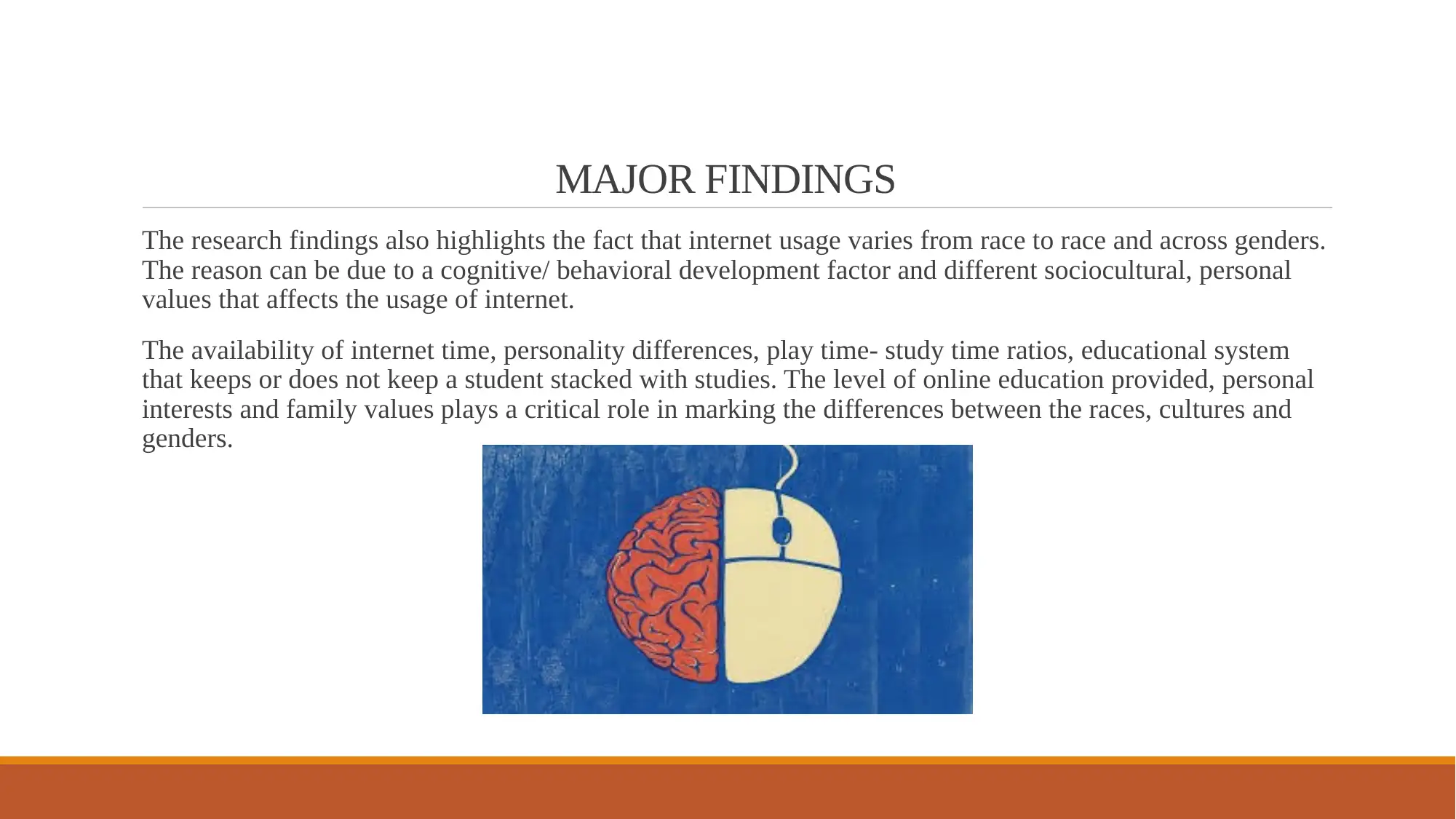
MAJOR FINDINGS
The research findings also highlights the fact that internet usage varies from race to race and across genders.
The reason can be due to a cognitive/ behavioral development factor and different sociocultural, personal
values that affects the usage of internet.
The availability of internet time, personality differences, play time- study time ratios, educational system
that keeps or does not keep a student stacked with studies. The level of online education provided, personal
interests and family values plays a critical role in marking the differences between the races, cultures and
genders.
The research findings also highlights the fact that internet usage varies from race to race and across genders.
The reason can be due to a cognitive/ behavioral development factor and different sociocultural, personal
values that affects the usage of internet.
The availability of internet time, personality differences, play time- study time ratios, educational system
that keeps or does not keep a student stacked with studies. The level of online education provided, personal
interests and family values plays a critical role in marking the differences between the races, cultures and
genders.
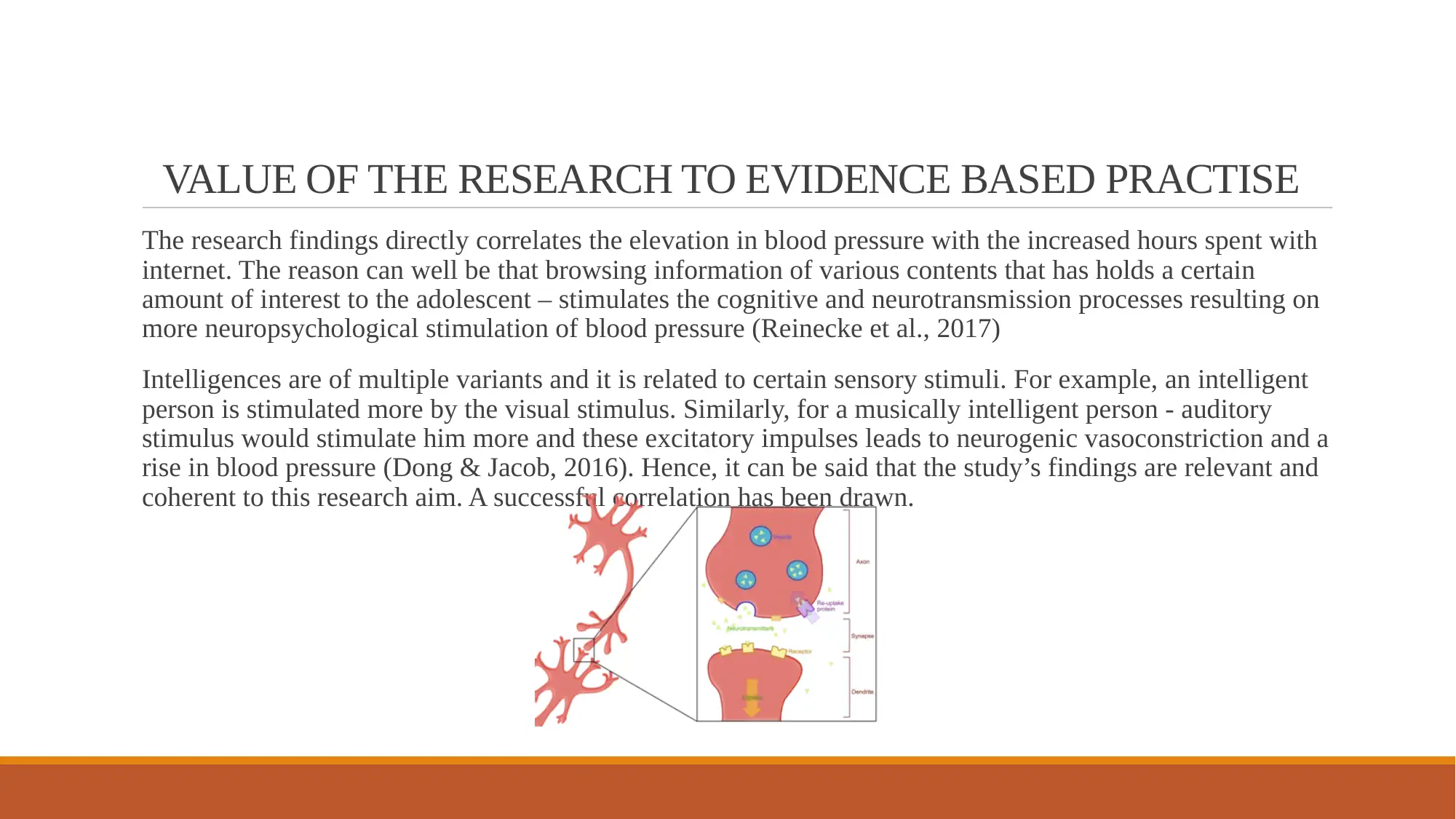
VALUE OF THE RESEARCH TO EVIDENCE BASED PRACTISE
The research findings directly correlates the elevation in blood pressure with the increased hours spent with
internet. The reason can well be that browsing information of various contents that has holds a certain
amount of interest to the adolescent – stimulates the cognitive and neurotransmission processes resulting on
more neuropsychological stimulation of blood pressure (Reinecke et al., 2017)
Intelligences are of multiple variants and it is related to certain sensory stimuli. For example, an intelligent
person is stimulated more by the visual stimulus. Similarly, for a musically intelligent person - auditory
stimulus would stimulate him more and these excitatory impulses leads to neurogenic vasoconstriction and a
rise in blood pressure (Dong & Jacob, 2016). Hence, it can be said that the study’s findings are relevant and
coherent to this research aim. A successful correlation has been drawn.
The research findings directly correlates the elevation in blood pressure with the increased hours spent with
internet. The reason can well be that browsing information of various contents that has holds a certain
amount of interest to the adolescent – stimulates the cognitive and neurotransmission processes resulting on
more neuropsychological stimulation of blood pressure (Reinecke et al., 2017)
Intelligences are of multiple variants and it is related to certain sensory stimuli. For example, an intelligent
person is stimulated more by the visual stimulus. Similarly, for a musically intelligent person - auditory
stimulus would stimulate him more and these excitatory impulses leads to neurogenic vasoconstriction and a
rise in blood pressure (Dong & Jacob, 2016). Hence, it can be said that the study’s findings are relevant and
coherent to this research aim. A successful correlation has been drawn.
⊘ This is a preview!⊘
Do you want full access?
Subscribe today to unlock all pages.

Trusted by 1+ million students worldwide
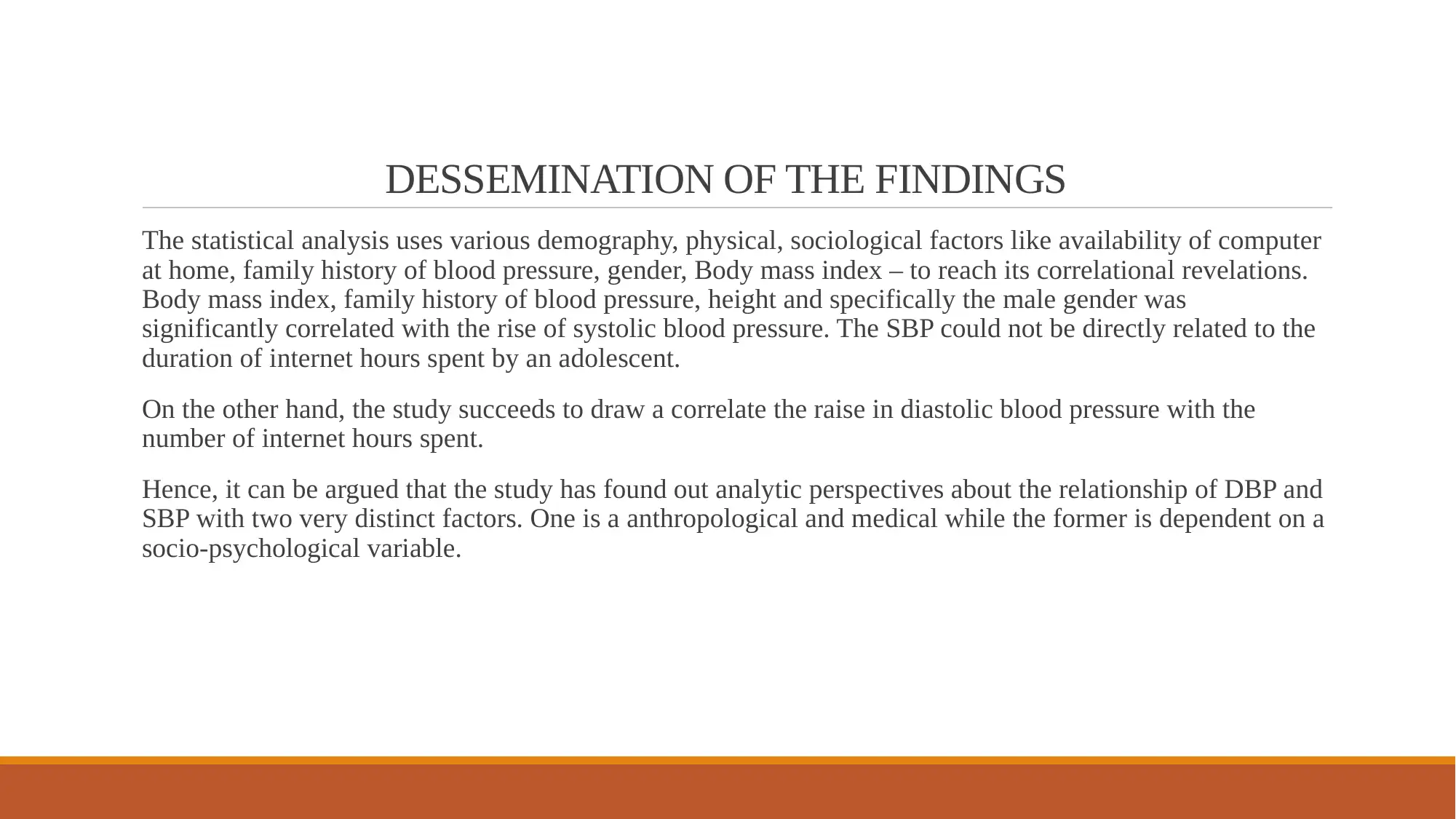
DESSEMINATION OF THE FINDINGS
The statistical analysis uses various demography, physical, sociological factors like availability of computer
at home, family history of blood pressure, gender, Body mass index – to reach its correlational revelations.
Body mass index, family history of blood pressure, height and specifically the male gender was
significantly correlated with the rise of systolic blood pressure. The SBP could not be directly related to the
duration of internet hours spent by an adolescent.
On the other hand, the study succeeds to draw a correlate the raise in diastolic blood pressure with the
number of internet hours spent.
Hence, it can be argued that the study has found out analytic perspectives about the relationship of DBP and
SBP with two very distinct factors. One is a anthropological and medical while the former is dependent on a
socio-psychological variable.
The statistical analysis uses various demography, physical, sociological factors like availability of computer
at home, family history of blood pressure, gender, Body mass index – to reach its correlational revelations.
Body mass index, family history of blood pressure, height and specifically the male gender was
significantly correlated with the rise of systolic blood pressure. The SBP could not be directly related to the
duration of internet hours spent by an adolescent.
On the other hand, the study succeeds to draw a correlate the raise in diastolic blood pressure with the
number of internet hours spent.
Hence, it can be argued that the study has found out analytic perspectives about the relationship of DBP and
SBP with two very distinct factors. One is a anthropological and medical while the former is dependent on a
socio-psychological variable.
Paraphrase This Document
Need a fresh take? Get an instant paraphrase of this document with our AI Paraphraser
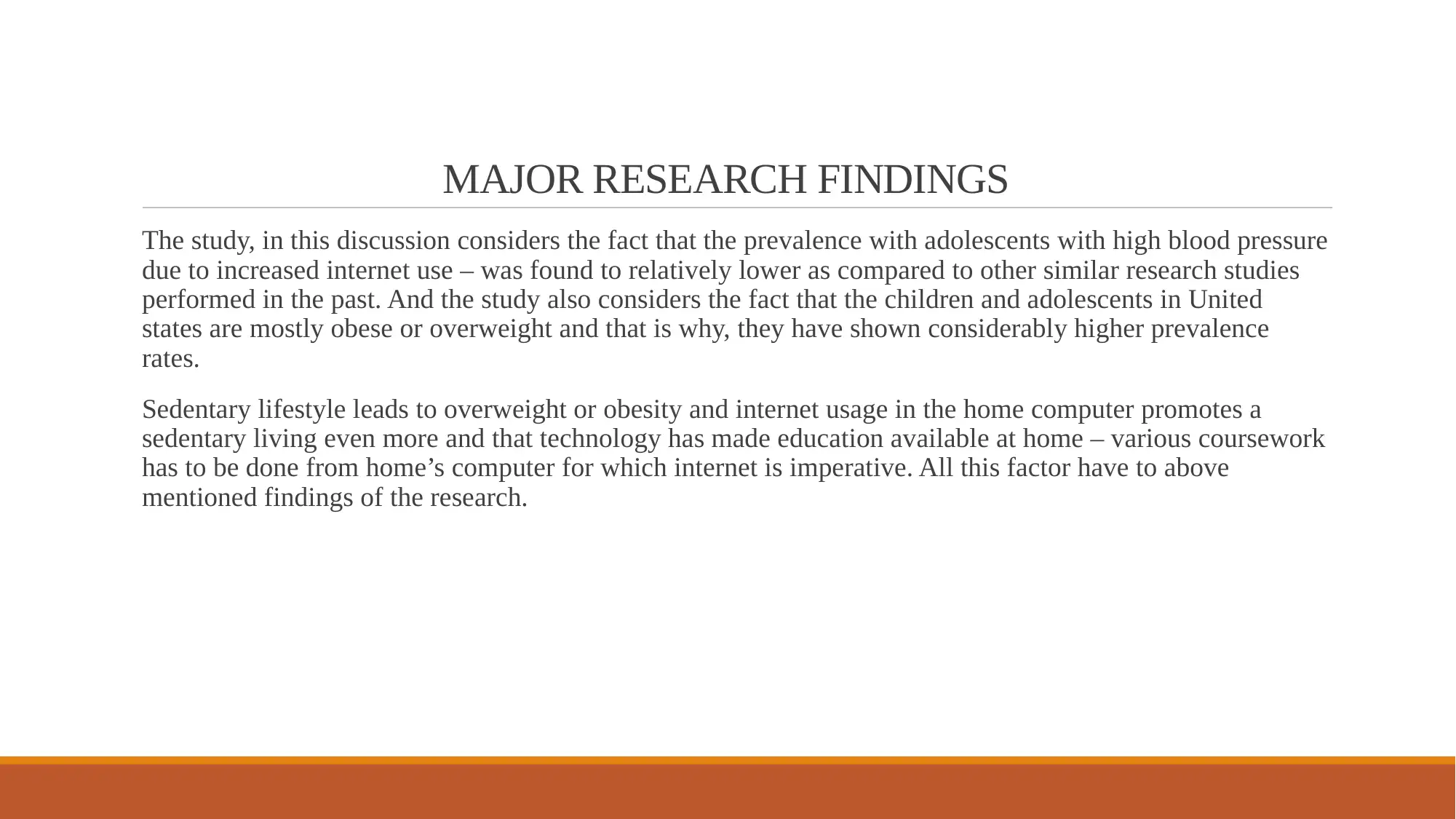
MAJOR RESEARCH FINDINGS
The study, in this discussion considers the fact that the prevalence with adolescents with high blood pressure
due to increased internet use – was found to relatively lower as compared to other similar research studies
performed in the past. And the study also considers the fact that the children and adolescents in United
states are mostly obese or overweight and that is why, they have shown considerably higher prevalence
rates.
Sedentary lifestyle leads to overweight or obesity and internet usage in the home computer promotes a
sedentary living even more and that technology has made education available at home – various coursework
has to be done from home’s computer for which internet is imperative. All this factor have to above
mentioned findings of the research.
The study, in this discussion considers the fact that the prevalence with adolescents with high blood pressure
due to increased internet use – was found to relatively lower as compared to other similar research studies
performed in the past. And the study also considers the fact that the children and adolescents in United
states are mostly obese or overweight and that is why, they have shown considerably higher prevalence
rates.
Sedentary lifestyle leads to overweight or obesity and internet usage in the home computer promotes a
sedentary living even more and that technology has made education available at home – various coursework
has to be done from home’s computer for which internet is imperative. All this factor have to above
mentioned findings of the research.
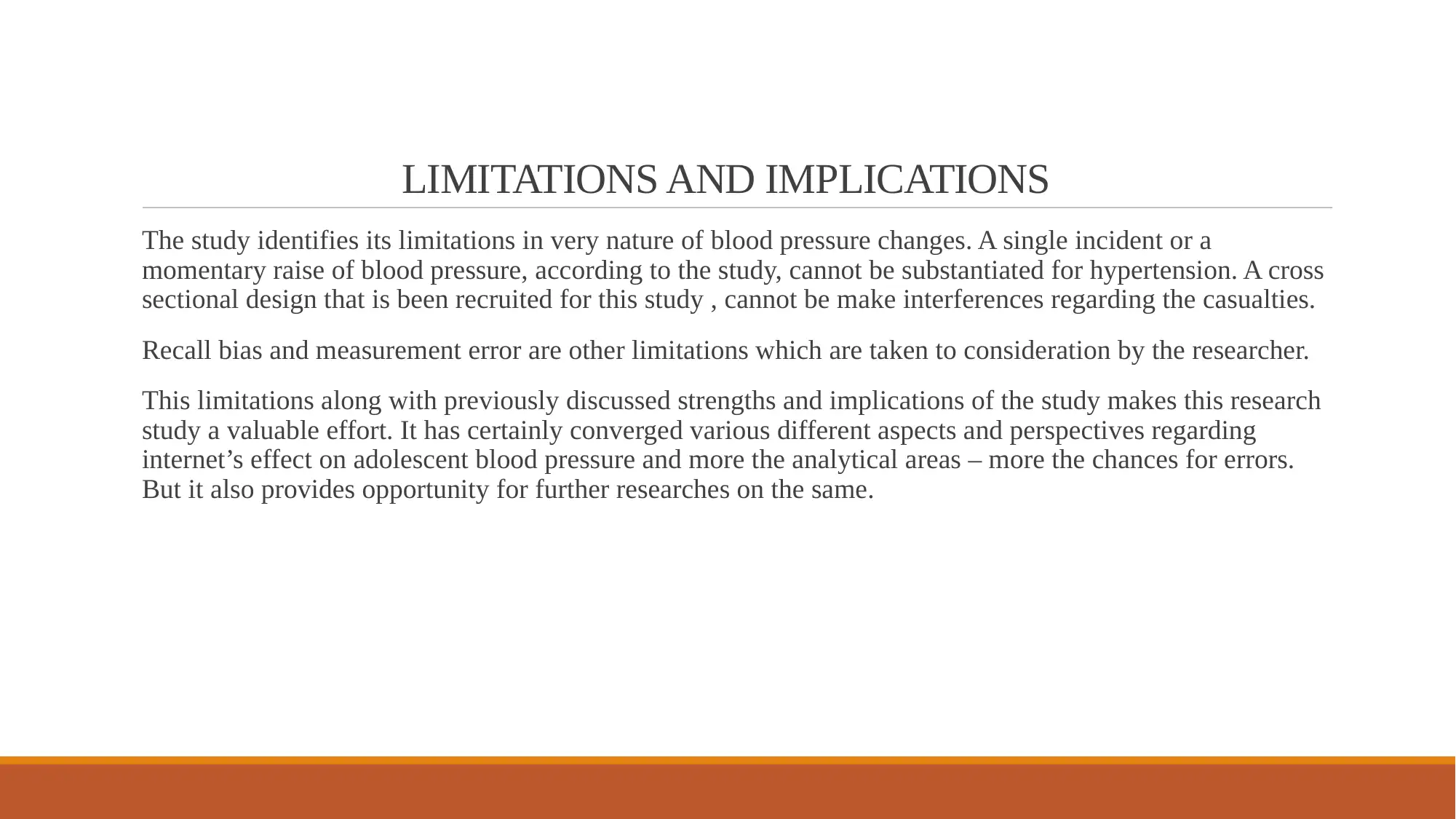
LIMITATIONS AND IMPLICATIONS
The study identifies its limitations in very nature of blood pressure changes. A single incident or a
momentary raise of blood pressure, according to the study, cannot be substantiated for hypertension. A cross
sectional design that is been recruited for this study , cannot be make interferences regarding the casualties.
Recall bias and measurement error are other limitations which are taken to consideration by the researcher.
This limitations along with previously discussed strengths and implications of the study makes this research
study a valuable effort. It has certainly converged various different aspects and perspectives regarding
internet’s effect on adolescent blood pressure and more the analytical areas – more the chances for errors.
But it also provides opportunity for further researches on the same.
The study identifies its limitations in very nature of blood pressure changes. A single incident or a
momentary raise of blood pressure, according to the study, cannot be substantiated for hypertension. A cross
sectional design that is been recruited for this study , cannot be make interferences regarding the casualties.
Recall bias and measurement error are other limitations which are taken to consideration by the researcher.
This limitations along with previously discussed strengths and implications of the study makes this research
study a valuable effort. It has certainly converged various different aspects and perspectives regarding
internet’s effect on adolescent blood pressure and more the analytical areas – more the chances for errors.
But it also provides opportunity for further researches on the same.
⊘ This is a preview!⊘
Do you want full access?
Subscribe today to unlock all pages.

Trusted by 1+ million students worldwide
1 out of 13
Related Documents
Your All-in-One AI-Powered Toolkit for Academic Success.
+13062052269
info@desklib.com
Available 24*7 on WhatsApp / Email
![[object Object]](/_next/static/media/star-bottom.7253800d.svg)
Unlock your academic potential
Copyright © 2020–2026 A2Z Services. All Rights Reserved. Developed and managed by ZUCOL.





